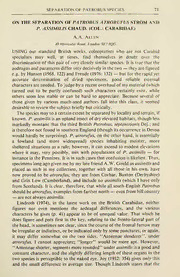
On the separation of Patrobus atrorufus Strom and P. assimilis Chaud. (Col.: Carabidae) PDF
Preview On the separation of Patrobus atrorufus Strom and P. assimilis Chaud. (Col.: Carabidae)
SEPARATION OF PATROBUS SPECIES 71 ON THE SEPARATION OF PA TROBUS A TRORVFUS STROM AND P. ASSIMILIS CHAUD. (COL.: CARABIDAE) A.A. Allen 49 Montcalm Road, London SE78QG. USING our standard British works, coleopterists who are not Carabid speciaHsts may well, at times, find themselves in doubt over the discrimination of this pair of very closely similar species.—It is true that the aedeagus and parameres differ very decisively in the two they are figured — e.g. by Hansen (1968. 122) and Freude (1976: 132) but for the rapid yet accurate determination of dried specimens, good reliable external characters are needed. To judge by a recent overhaul ofmy material (which turned out to be partly confused) such characters certainly exist, while others seem less stable or can be hard to appreciate. Because several of those given by various much-used authors fall into this class, it seemed desirable to review the subject briefly but critically. The species may to a certain extent be separated by locality and terrain, if known. P. assimilis is an upland insect ofdry elevated habitats, though less markedly montane that the third British Patrobus, septentrionis Dej.; and is therefore not found in southern England (though its occurrence in Devon would hardly be surprising). P. atrorufus, on the other hand, is essentially a lowland (and more widespread) species inhabiting moister, more sheltered situations as a rule; however, it can ascend to modest elev—ations where it may, very possibly, mix with populations of P. assimilis for instance in the Pennines. It is in such cases that confusion is likeliest. Thus, specimens long ago given me by my late friend A.W. Gould as assimilisand placed as such in my collection, together with all those in his own, have now proved to be atrorufus; they are from Corbar, Buxton (Derbyshire) and Grin Low (Cumberland), and include no assimilis (which I have only from Scotland). It is clear, therefore, that while all—south-English Patrobus should be atrorufus, examples from farther north even from hill country — are not always assimilis. Lindroth (1974), in the latest work on the British Carabidae, neither figures nor even mentions the aedeagal differences, and the various characters he gives (p. 41) appear to be of unequal value. That which he does figure and puts first in the key, relating to the fronto-lateral part of the head, is sometimes not clear, since the course ofthe frontal furrow may be irregular or indistinct, or be indicated only by some punctures; or again, it may differ somewhat on the two sides. "Antennae slenderer", under atrorufus, I cannot appreciate; "longer" would be more apt. However, "Antennae shorter, segments more rounded" under assimilisis a good and constant character, and the slightly differing length of these organs in the two species is perceptible to the naked eye. Joy (1932: 354) gives only this and the small difference in average size. Though Lindroth states that the 72 ENTOMOLOGIST'S RECORD, VOL. 103 25.iii.1991 first and third segments are of equal length in assimilis, the latter usually appears the longer, but less obviously so than in atrorufus. Of the remaining key-characters he gives, the best seem to be those of the elytral striae, which are clear on comparison (in atrorufus more finely punctate and much less evanescent apically). Fowler (1887: 129-130), besides giving these latter differences, states that the third elytral interval is plainly wider than the second in assimilis, but not in excavatus (i.e. atrorufus). The other works I have at hand do not mention this character, but in fact it would appear from my very limited material to be an excellent one, definite and not dependent on comparison of the two species. I would add another which I believe will prove satisfactory, concerning the basal pronotal foveae: in assimilis the whole fovea is evenly and rather strongly punctate, whereas in atrorufus its outer part is almost impunctate and smooth, with the external ridge or keel better developed and more distinctly set off. To sum up: in practice it will probably be found sufficient to use, con- jointly, the characters of the antennae, pronotal foveae, and elytral striae to effect reliable determination with the minimum oftrouble. References Fowler, W.W., 1887. The Coleopteraofthe British Islands, 1. London. Freude, H., in Freude, H., Harde, K.W., & Lohse, G.A., 1976. Die Kafer Mitteleuropas, 2. Krefeld. Hansen, V., 1968. DanmarksFauna 7(5(Bil]er24). Kobenhavn. Joy, N.H., 1932. A practicalhandbook ofBritish beetles, 1. London. Lindroth, C.H., 1974. Handbooks for the Identification of British Insects 4(2): Coleoptera, Carabidae. R. ent. Soc. London. Plodia interpunctella Hiibner, the Indian meal moth (Lep.: Pyralidae) in Bedfordshire. On a recent visit to one of our local pet stores, I noticed a great many pyralid moths flying around aquarium lights and resting on the shop's inner walls. Several were caught (much to the amusement of the other customers and the proprietor) and taken home for identification. Reference to Goater, B. {British Pyralid Moths, Harley, Colchester, 1986) revealed them to be P. interpunctella. With the permission of the shop's owner, I subsequently examined a tub of rabbit food and found it to be infested with lepidopterous larvae. A handful of the cereal and grain mixture was removed and a steady stream of adult P. interpunctella have since emerged. The business in question is primarily a tropical fish supplier and the temperature and humidity in the shop are kept very high by the large number of heated fish tanks. Perhaps as a consequence of this, P. — interpunctella appears to be continuously brooded therein. Adrian M. Riley, 35 Park Mount, Harpenden, Herts AL5 3AS.
